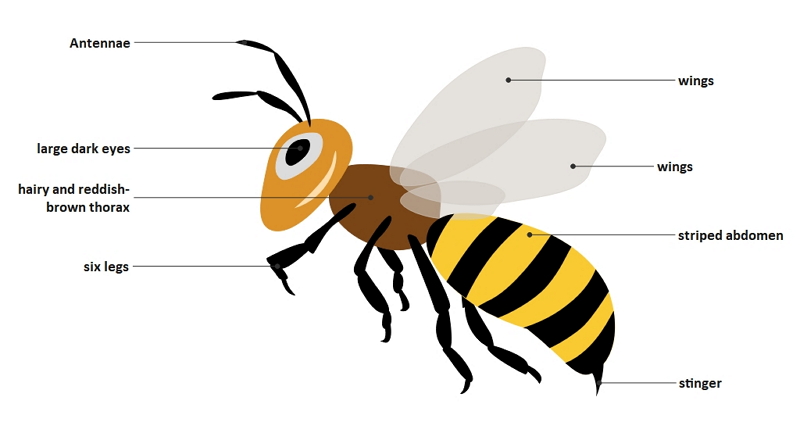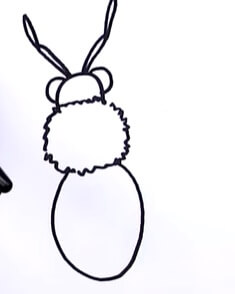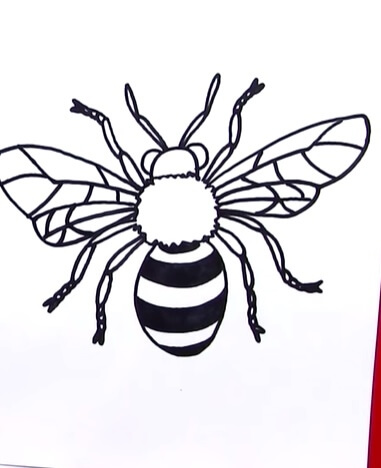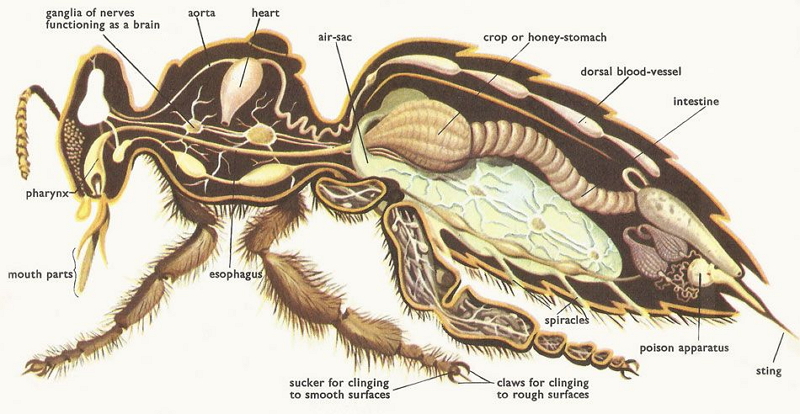A Guide to Understand Honeybee Anatomy with Diagram
Honeybees are complex insects, and they show a pattern of adaptation as social insects. They also have three distinct sections among the bees, and their anatomy is dependent on them. It is significant to learn their anatomy to study the nature of honeybees. The students can use honeybee anatomy diagrams for their lessons. They can avoid the hassle of creating the diagram by hand with the help of the EdrawMax Online tool.
1. The Honeybee Anatomy
Honeybees are the social insects belonging to the genus Apis. They form colonies and have distinct divisions of tasks.
There are around eight recognized species of honeybees with 43 subspecies. Each colony of honeybees has three distinct types of bees, and their body structure and tasks depend on their nature. The primary part of their body comes with the head, thorax, and abdomen.

1.1 The Classification of Bees
Queen bee:
- Queen bees can be recognized by their elongated abdomens extended beyond their wings.
- The queen fulfills the role of the reproductive female in the colony, and she lays eggs.
- A queen bee can live up to five years, but they stay reproductively active for 2-3 years.
- Queen bees release a pheromone, namely a queen substance.
Worker bee:
- They are the smallest among the bees.
- They are female bees generally unable to reproduce.
- They have well-developed compound eyes and elongated tongues to get nectar from flowers.
- Their function in the hive includes secretion of wax to form honeycombs, preparation of honey from the nectar, formation of royal jelly, etcetera.
- The lifespan of a worker bee is around five to six weeks.
Drones:
- They are the male bees.
- They play the part of the male reproductive counterpart fertilizing the queen bee.
- They are larger than workers and have longer antennae than the queen and the worker bees.
- Drones are born from unfertilized eggs.
1.2 The Structure of a Honeybee
Wings: Honeybees have strong wings, which can help them fly fast. They have four wings, and the structure named Hamuli allows bees to couple their wings. They can also fold the wings while resting.
Eyes: The compound eyes of honeybees have 6500 facets to allow them to see their top, bottom, and sides. They can see all the colors except for red, and their eyes can also see the UV lights.
Antennae: Antennae work as the sensory organ of the honeybees. They help the bee to locate their food, communicate with their team. They can also relay information with the help of their antennae.
Branched Setae: The body of a honeybee is covered with feathery hairs known as branched setae. When a bee sits on a flower, the pollen grains get stuck to their bodies on the setae. Some of these pollen grains fall on the other flowers and cause fertilization. Other pollen grains get transferred to their pollen sac, which they carry to their hives.
Legs: Honeybees have six legs that have claws and sticky pads. It helps them to stand on the rough surfaces and the smooth ones. The arrangement of the setae of their legs supports them in more than one way. Setae arrangement allow them to clean the debris from their hives, carry pollen, and remove pollen grains from their body.
Pollen basket: A pollen basket is a layer of stiff hairs grown around the flattened section of the honeybee’s back legs. They use this system to carry pollen to their hive. They use their other legs to remove the pollen grains from their body.
Proboscis: Honey bees have long tongues or proboscis, which they use to suck the nectar from the flowers. This elongated tongue is straw-like and can take in fluids.
Wax glands: There is a wax gland present at the bottom of the bee's abdomen, secreting beeswax flakes. They use it to form their hives and make honeycombs.
Honey Bee mandibles: The honey bee mandibles are strong and have strong muscles. They clear debris from hives, form honeycombs from wax, attack the intruders and defend them.
Warning colors: The black and yellow stripes on the bees' backs are known as nature’s warning colors, which indicate that the insect can be nocuous for them. These warning colors have become a defense mechanism for many harmless insects.
Stingers: The stingers of the honey bees are generally modified ovipositors and hence are there in the worker bees. They are barbed like fish-hooks which makes it challenging to come out. They are attached to the venom sac. As the venom sac and stinger get removed after stinging, the bee dies.
 Source:EdrawMax Online
Source:EdrawMax Online
2. How to Draw the Honeybee Anatomy?
To understand the honeybee anatomy, the students may use a diagram that can make the learning smoother. Honeybee anatomy is complex, and hence to create a honeybee anatomy diagram, the students need to follow this guide.
2.1 How to Create Honeybee Anatomy from Sketch
Creating such a diagram by hand can be difficult. The students can follow these steps to make their honeybee anatomy:
Step 1: They need to draw an oval shape. At the sides of this oval shape, they have to draw two black circles, which make the compound eyes of the honeybee. At the top of their eyes and towards the front of the head, there are the antennae. Students should draw that in this first step. In this step, students should also draw thorax and abdomen. The abdomen is also oval-shaped with a more elongated end, whereas the thorax is pretty hairy and fuzzy. They are the connector between the head and the body.

Step 2: Four wings are present on the thorax, and the forewings are comparatively larger than the hind wings. Near the junction of the head and thorax, the forelegs are present.

Step 3: The third part involves coloring each part. The abdomen part is bigger and oval-shaped with yellow and black stripes on them. The middle legs are present at the end of the thorax part, while the abdomen has a pair of hind legs. The legs have claws at the end.

2.2 How to Create Honeybee Anatomy Online
It is pretty challenging and time-consuming to create a honeybee anatomy diagram by hand. Moreover, the students may not get satisfactory results. They must use the EdrawMax Online tool. It can help them to create a high-quality honeybee anatomy diagram. Here are a few simple steps which they can follow:
Step 1: EdrawMax Online tool is user-friendly, and hence the students can comfortably work on this tool. To start with the honeybee anatomy diagram, they need to open the EdrawMax Online and then open New. Under this section, there is the Science and Education tab. There are several high-quality diagrams present in that section. The students can use it for their lessons and projects.

Step 2: The students need to look for the Biology option. This part has a wide range of biology-related diagrams. The students can select the honeybee anatomy diagram from this part and modify those diagrams as per their choice.

Step 3: After selecting the template they require, the students should modify it as per their choice. The tool gives the students some hassle-free options to edit their diagrams. They can work on those images according to their preference to create a high-quality honeybee anatomy image.

Step 4: Once they complete the diagrams, they can save them in multiple file formats and export them for their projects and dissertation papers.
 source:Pinterest
source:Pinterest
3. The Internal Anatomy of a Honeybee
Head:
- The head of honeybees has a tube-shaped hypopharyngeal gland that secrets royal jelly.
- They have five eyes, including two compound eyes and three simple eyes.
- They have proboscis to suck nectar from flowers.
- Their antennae act as sensory organs.
Thorax:
- The head and abdomen of a honeybee are joined with the thorax, which has three spiracles.
- The thorax has anchors for the legs; the forelegs help clean the antennae, while the hind legs act as pollen baskets.
- It also has flight muscles, which increase their speed of beating the wings.
- Thorax of honeybees also has the salivary gland.
- There are two pairs of wings attached to the thorax of the honeybees.
Abdomen:
- Spiracle holes that help them in breathing are there on the sides of their abdomen.
- The honey stomach present in their abdomen allows them to carry nectar from flowers to their hive.
- The ovipositors of the honeybees are transformed into stringers that are attached to the venom sac.
 Source: Pinterest
Source: Pinterest
4. Conclusion
The students can use the honeybee anatomy diagram to gain thorough knowledge about the honeybee and their anatomy. However, it is challenging enough to create a good-quality honeybee anatomy diagram by hand, and at the same time, it may take a long time. The students must use the EdrawMax Online tool, which can help them draw a high-quality diagram for their lessons.
In conclusion, EdrawMax Online is a quick-start diagramming tool, which is easier to make honeybee anatomy diagram and any 280 types of diagrams. Also, it contains substantial built-in templates that you can use for free, or share your science diagrams with others in our template community.




